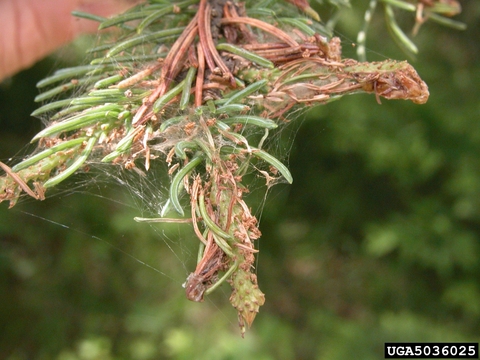Eastern spruce budworm (Choristoneura fumiferana) is a native insect found in the coniferous forests of northeastern Minnesota that feeds on and kills balsam fir and spruce trees. It primarily feeds on the buds of balsam fir (Abies balsamea) and white spruce (Picea glauca). When populations are high enough, spruce budworm can also feed on black spruce (Picea mariana), tamarack (Larix laricina), and pines (Pinus spp.). Balsam fir is most susceptible to impacts from spruce budworm and is unlikely to survive under several years of defoliation.
Unlike invasive species such as emerald ash borer, spruce budworm is a native insect of Minnesota so there are natural controls present in the ecosystem that have co-evolved with spruce budworm in our forests. This ecology is very complex—spruce budworm populations are thought to be controlled by a combination of factors, including natural predators, pathogens, and the availability of host trees white spruce and balsam fir.
Large-scale outbreaks of spruce budworm typically occur every 25 to 40 years in Minnesota, and impacts from budworm activity have been observed in Minnesota every year since at least 1954.
How does spruce budworm impact trees and forests?
Trees prioritize their energy expenditure in different ways throughout their lifetime. For example, trees will put their energy towards vertical or horizontal growth, growing roots and shoots, or producing cones or flowers.
When spruce budworm eats the buds of a tree, the tree shifts its energy away from new growth and towards maintaining its defenses and resisting the impacts of the budworm. This shift results in the tree becoming stressed, and a stressed tree is not a healthy tree.
While trees often can withstand this stress, the risk of death increases when stressors become compounded, such as when a drought occurs in addition to spruce budworm feeding.
Maintaining a delicate balance
The life cycle of spruce budworm begins when adult moths lay egg masses on spruce and balsam fir needles in July and August. Those eggs hatch into larvae, which overwinter in silk coverings called hibernacula. They then emerge to feed on the new buds of balsam fir and spruce trees in May and June. After feeding, larvae pupate and emerge as adult moths, and the cycle begins again.
The natural predators of spruce budworm are numerous and feed on various life stages of the budworm; they include birds, spiders, beetles, ants, flies, dragonflies, and small mammals.
One of the most fascinating ecological dynamics of spruce budworm involves parasitoid wasps. Parasitoid wasps lay their eggs inside spruce budworm larvae, which eventually kill them.
Understanding the exact impacts of climate change on spruce budworm populations can be difficult, due to the complexity of forest ecosystems. External factors exacerbated by climate change such as drought have heightened the severity of spruce budworm outbreaks in recent years. Spruce budworm also exhibits temperature sensitivity across the life cycle. Larvae typically prefer hot, dry summers, but a warm fall or spring can speed up the metabolism of the overwintering larvae, resulting in death. Adult moths fly only when temperatures are between 14°C (57°F) and 30°C (86°F).
Spruce budworm management
The management of spruce budworm in forests depends on the species and age of host trees in the forest, the health of the trees, and the management history of the stand. Forests with a high density of balsam fir should be harvested as soon as possible to maintain their value and to reduce the fire risk (fuel load) since dead balsam fir is a ladder fuel that can carry fire into the forest canopy.
Spruce stands can be thinned depending on their age. However, spruce stands should not be thinned during an active outbreak or a drought, as this can result in thinning shock—temporary reduced vigor or function that can negatively impact the health of the stand.
Spraying insecticides such as Btk (Bacillus thuringiensis kurstaki) over forest stands can be successful during moderate outbreaks, but the cost of multiple sprayings and uncertain success make this option much more costly compared to other management strategies such as thinning.
Ultimately, the management of your woodland depends on your goals and desired future conditions. If your woodland is susceptible to or already impacted by spruce budworm, contact a natural resource professional to develop a plan to improve the health and resilience of your woodland.
Bowden, J. J., van der Meer, B., Moise, E. R. D., Johns, R. C., & Williams, M. (2023). Not just for the birds: Spiders as natural enemies of spruce budworm (Choristoneura fumiferana, Clem.). Journal of Applied Entomology, 147(2), 176–180. https://doi.org/10.1111/jen.13096
Minnesota Department of Natural Resources. Eastern spruce budworm. https://www.dnr.state.mn.us/treecare/forest_health/spruce-budworm/index
Moise, E. R. D., Warren, J., & Bowden, J. J. (2024). Impacts of winter warming events on spruce budworm: The importance of timing. Journal of Insect Science, 24(2), 17. https://doi.org/10.1093/jisesa/ieae037
Pureswaran, D. S., Johns, R., Heard, S. B., & Quiring, D. (2016). Paradigms in Eastern Spruce Budworm (Lepidoptera: Tortricidae) Population Ecology: A Century of Debate. Environmental Entomology, 45(6), 1333–1342. https://doi.org/10.1093/ee/nvw103
Régnière, J., Venier, L., & Welsh, D. (2021). Avian Predation in a Declining Outbreak Population of the Spruce Budworm, Choristoneura fumiferana (Lepidoptera: Tortricidae). Insects, 12(8), 720. https://doi.org/10.3390/insects12080720
Royama, T. (1984). "Population Dynamics of the Spruce Budworm Choristoneura fumiferana" (PDF). Ecological Monographs. 54 (4): 429–462. https://doi.org/10.2307/1942595
University of Massachusetts Amherst. Choristoneura fumiferana. https://ag.umass.edu/landscape/publications-resources/insect-mite-guide/choristoneura-fumiferana



